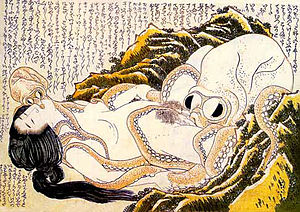The Dream of the Fisherman's Wife
From Wikipedia, the free encyclopedia

The Dream of the Fisherman's Wife (蛸と海女 Tako to ama, Octopus (or Octopi) and Shelldiver) is an erotic woodcut of the ukiyo-e genre made around 1820 by the Japanese artist Katsushika Hokusai. Perhaps the first instance of tentacle eroticism, it depicts a woman entwined sexually with a pair of octopuses, the smaller of which wraps one of its tentacles around the woman's nipple and kisses her, while the larger one performs cunnilingus. Hokusai created The Dream of the Fisherman's Wife during the Edo period in when Shinto was making a resurgence; this influenced the piece's animism and playful attitude towards sexuality. It is a celebrated example of shunga and has been reworked by a number of artists. Similar themes of human females having sexual intercourse with sea life have been displayed since the 17th century in Japanese netsuke, small carved sculptures only a few inches in height and often extremely elaborate.
In Richard Lane's Images of the Floating World (1978) this print is referenced as Girl Diver and Octopi from the series Young Pine Shoots (1814). Mathi Forrer in Hokusai: Prints and Drawings (1992) titles it Pearl Diver and Two Octopi from Young Pines (Kinoe no komatsu) with the same 1814 date.
[edit] Influence
Kaneto Shindo includes the image in his 1981 film Hokusai manga, an account of Hokusai's life. It stars Ken Ogata as Hokusai and Yuko Tanaka as his daughter Oei. A shot of the work printed on a postcard that is being looked at by Anaïs Nin (Maria de Medeiros) at the beginning of the 1990 film Henry & June earned that movie the very first NC-17 film rating. A print of this work hangs in the office of senior partner Bertram Cooper (Robert Morse) in the AMC TV series Mad Men. In the Kenny vs Spenny competition of who could wear a dead octopus the longest on his head, Kenny is wearing a t-shirt with this print on it.
[edit] References
- Images from the Floating World, Richard Lane, 1978, Koneckey & Konecky, p. 163.
- Hokusai: Prints and Drawings, Mathi Forrer, 1992, Prestel, ill. 124.
- Patrick T.M. Kenny, “Conflicting Legal and Cultural Conceptions of Obscenity in Japan: Hokusai's Shunga and Oshima Nagisa's L'Empire des sens.” Earlham College thesis, 2007.

